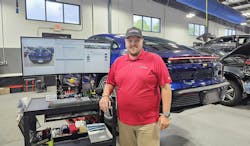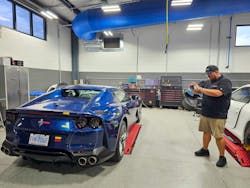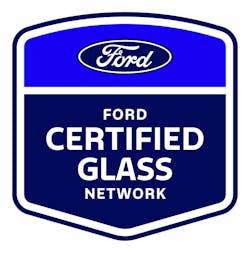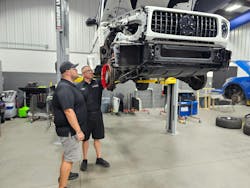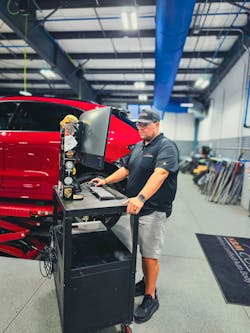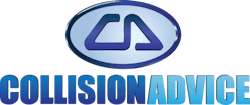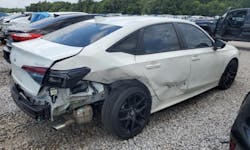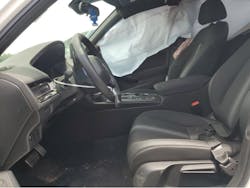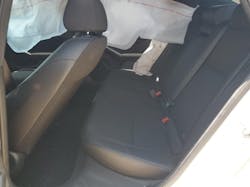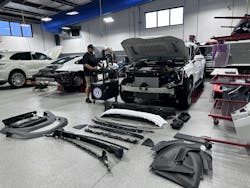As production manager of K&M Collision in Hickory, North Carolina, Will Barkley wears a few hats, including as repair planner for some of the shop’s most sophisticated vehicles.
“Will is, without question, the driving force behind our shop’s overall success,” says Michael Bradshaw, vice president of K&M Collision in his nomination of Barkley as the 2025 FenderBender/ABRN Best Repair Planner. “As production manager, he not only oversees scheduling and workflow but also acts as the go-to resource for every technician. From troubleshooting complex structural repairs to clarifying parts or procedures, Will ensures his colleagues have the support, information, and confidence they need to excel.”
With Barkley’s focus on luxury vehicles, including Aston Martin, Bentley, Ferrari, and Porsche, he is responsible for $500,000 to $600,000 in monthly sales, Bradshaw says, and is a major contributor to the shop’s monthly total of $1 million in sales.
At 36, Barkley has been working in the automotive business for over 11 years. He started doing many tasks for a used car dealer before coming to work at K&M, which he recalls was a smaller shop at the time. He started at K&M in the front office answering phones and completing paperwork. But as technicians disassembled vehicles, Barkley took notes. Bradshaw then began teaching him how to write estimates. Then for a time, he pulled double duty with parts and estimating before the shop grew and hired a dedicated parts team.
“Just learning the breakdown of all the parts tremendously helped me when it came time to start repair planning,” Barkley says. He’s been doing at least some of the repair planning for nearly eight years and points to ongoing training as helping keep his skills sharp. (Bradshaw notes that Barkley has a parts-ordering accuracy of 98.3%.)
“Between OEM training, some I-CAR training, going to Mike [Anderson]’s classes, and others, just building on the information it takes to be able to put a 100%-accurate blueprint out there takes a lot of time and effort.”
Bradshaw says Barkley has a “meticulous approach to planning, grounded in OEM directives and best practices, which serves as a benchmark for the entire shop.”
Because some of the luxury and exotic brands don’t offer standardized estimating databases, Bradshaw notes, that makes his “thorough and detailed repair plans all the more exceptional.”
And beyond his repair planning skills, Barkley leads with active mentoring.
“He takes time to provide personalized coaching to technicians, walking them through advanced repair procedures and OEM-specific requirements,” Bradshaw continues. “By remaining accessible and engaged, Will not only elevates our team’s technical expertise but also fosters a workplace culture defined by mutual respect and continuous improvement. Over time, this emphasis on teamwork and high standards has garnered him multiple peer-nominated awards, underscoring how deeply his peers value his contributions.
“In every facet of his work — be it production oversight, direct repair planning, or team building — Will demonstrates the unwavering commitment, industry expertise, and leadership qualities that make our shop stand out. He embodies the professionalism and passion that keep our facility operating at peak performance, setting an example that resonates with every member of our team.”
After Barkley’s nomination was selected with those of five other finalists, Barkley returned the most complete and accurate estimate and was named the winner of our second-annual Best Repair Planner/Estimator Award.
The Concept for the Contest
Modern vehicles have never been safer. Multiple advanced driver assistance system (ADAS) features help drivers avoid collisions, and in the event of a collision, the cabin’s integrity and multiple restraint system components better protect occupants. But at the same time, to retain those safety features once a collision-damaged vehicle is returned to the road, the demands on our readers have never been higher. The same features that provide built-in safety also require specific original equipment manufacturer (OEM) repair procedures for repair, replacement, and calibration, to name just a few considerations.
At FenderBender and ABRN, we wanted to recognize the importance of the repair planners and estimators who are models of professionalism and excellence in striving to make sure the vehicles repaired in their facilities are restored to as-built crashworthiness. So last year, we introduced the Best Repair Planner/Estimator Award. We were greeted with an enthusiastic response from the industry. As was the case last year, we solicited and received nominations from shop managers, supervisors, and colleagues from throughout the country. Competition was extremely close, which made for demanding judging. Our in-house panel reviewed each submission for attributes, such as the repair planner’s commitment to continuing education, work ethic, and his or her attitude in the shop to coworkers. For being named Best Repair Planner/Estimator, Barkley won a trip for two to the 2025 SEMA Show, where we will present his award to him at the Collision Industry Red Carpet Awards ceremony.
Industry Support and the Difficult Process of Selecting a Winner
Thank you to this year’s sponsors, Ford Motor Co. and PPG, who allow us to recognize Barkley and help bring attention to the need for quality, safe repairs. We’d also like to give a special thank you to Mike Anderson and his staff at Collision Advice for their expertise and assistance with the estimating portion of the awards selection process.
Once we narrowed our selections to six finalists, Collision Advice provided an estimate exercise with the stated goal to identify participants’ understanding of OEM repair guidelines and not-included operations. Any estimating system could be used, while participants were encouraged to use additional resources, such as repair information, the owner’s manual, OEM position statements, and more.
A 2025 Honda Civic was located at a salvage pool website, and photos of its VIN label and damage, plus the color code (NH883P) were shared with contestants. The instructions for the contestants were to write a repair plan using the estimating system of their choice to replace the rear bumper, right blind spot monitor, right quarter panel, right rear door, and right rocker molding, and to repair the right front door with a repair time of four hours.
Additionally, contestants were advised to research the SRS replacement needed based on what could be seen from deployment. They were also instructed to write the estimate not according to insurance guidelines. Instead, the goal of the mock estimate was to refer to OEM repair guidelines and not-included repair operations. Standard rates for labor, paint and materials, and sales tax were used, such as $50 for all rate categories (including Body, Paint, Frame, Mechanical, Structural, etc.) and $35 for paint and materials.
We sent the mock estimate to the finalists. Completed estimates ran a low of about $22,000 less tax to almost $39,000 less tax, which was Barkley’s winning entry. Although the exercises were not judged solely on the number of lines or the highest dollar value, as was the case last year, those with the most lines also captured the most operations related to safety and proper (OEM repair) procedures. In fact, both Barkley and a close runner-up each had about 450 lines for their estimates. In addition, Barkley included other supporting documents from RepairLogic showing the repair plan procedures he’d researched, along with a 1xID Report showing the single-use parts used on the estimate (a total of 44 single-use parts), plus another showing he’s checked for recalls (there were no open recalls for the subject vehicle.)
“For this year’s contest, the quality of estimates submitted was on an entirely new level,” Anderson says. “This year’s winner displayed a complete understanding of utilizing the OEM procedures to determine and identify those required for a safe and proper repair. In addition, the itemization of not-included operations was superb. Will’s thoroughness of detailed estimate accuracy proved without a reasonable doubt his ability to write an accurate damage analysis.”
Tricks of the Trade
As he demonstrated in his completed estimate exercise, Barkley references OEM repair instructions to identify all necessary labor steps and non-included operations, such as trim removal, specialty fastener replacements, or paint-related tasks.
“By proactively including these items in the initial repair plan, he minimizes the need for supplements and ensures every operation is billed accurately,” Bradshaw says.
Barkley says he stays up to date on technical training through I-CAR (he’s Platinum-recognized,) OEM training programs, and more. His office is on a mobile workstation in the shop with a widescreen monitor. Working with one of the three technicians on his team, Barkley’s team’s process is similar for different makes and models. As the vehicle is disassembled, parts are sorted by category (such as bumper parts, fender parts, etc.) on the floor or on a cart, arranged by how they’re installed on the vehicle. Undamaged parts are wrapped and stored on parts carts using a bin system.
“The idea of that is as I build my estimate, I'm sorting my parts on my cart that are damaged and then if I get to the end and I miss something that's, you know, it should still be laying on the floor,” Barkley says.
All one-time-use fasteners, adhesives, fluids, and prep supplies are identified at the same time before work begins. “This approach reduces downtime or work stoppages, preventing surprises mid-repair and supporting a more efficient workflow,” Bradshaw says.
Bradshaw says Barkley compiles a dedicated file of repair information for each job, which may include service bulletins, updated OEM repair procedures, and relevant calibration requirements.
“He then reviews this file with the technician, outlining key steps, potential challenges, and the rationale behind each stage of the repair process. This open communication fosters collaboration and accountability.”
Beyond that, Barkley’s meticulous documentation of each OEM-recommended process and its associated cost provides transparency and justification, Bradshaw says. “This thorough documentation simplifies discussions with insurance companies or other bill payers, ensuring correct compensation while maintaining a clear record of how customer vehicles are restored to pre-loss condition.”
Tips for Repair Planners
Barkley says one of the biggest improvements repair planners can make is to try to identify and order all parts at the time of writing the repair plan and ensuring all needed parts have been ordered and received by the parts department. Doing so alleviates stress for the repair planner, technicians, and parts department. After a car has gone through the paint process and ready for reassembly is not the time to find out one little part installed behind the bumper cover is missing, he points out, and now it is going to take three weeks for it to arrive from Germany.
“Maybe that part was missed, or maybe the tech never pulled it off the car. Maybe they noticed it when they're putting it back together. So take that extra 10 or 15 minutes, whatever it is, just to kind of recap with your tech. It's 100% making sure you've got that buttoned up so you can send it on down the process.
He’ll refer to the scans to try to determine if there are any defective modules, if any wiring has issues, and what calibrations will be needed after the vehicle is repaired. What modules will need to be reprogrammed? Does it need tires or a wheel alignment? What safety inspections are needed?
“You have to just work your way through what does that car need to be able to have a 100% repair plan,” Barkley says. “The bigger portion of that is just understanding you may have a 2020 model vehicle that you're working on today and tomorrow you've got a 2023 vehicle that has substantially different ADAS systems.
"Just because I worked on this Mercedes and it has these systems, this vehicle three years later may have the same functionality but have completely different systems. I don't know anybody who can memorize all that stuff and keep track of it. So, have the discipline to go into the OEM repair procedures every time to see what you're working on.”
About the Author
Jay Sicht
Editor-in-Chief, FenderBender and ABRN
Jay Sicht is editor-in-chief of FenderBender and ABRN. He has worked in the automotive aftermarket for more than 29 years, including in a number of sales and technical support roles in paint/parts distribution and service/repair. He has a bachelor's degree in journalism from the University of Central Missouri with a minor in aviation, and as a writer and editor, he has covered all segments of the automotive aftermarket for more than 20 of those years, including formerly serving as editor-in-chief of Motor Age and Aftermarket Business World. Connect with him on LinkedIn.
Don't miss Jay's next article or podcast. Sign up for FenderBender Today's Collision Repair News and ABRN eNews here.
